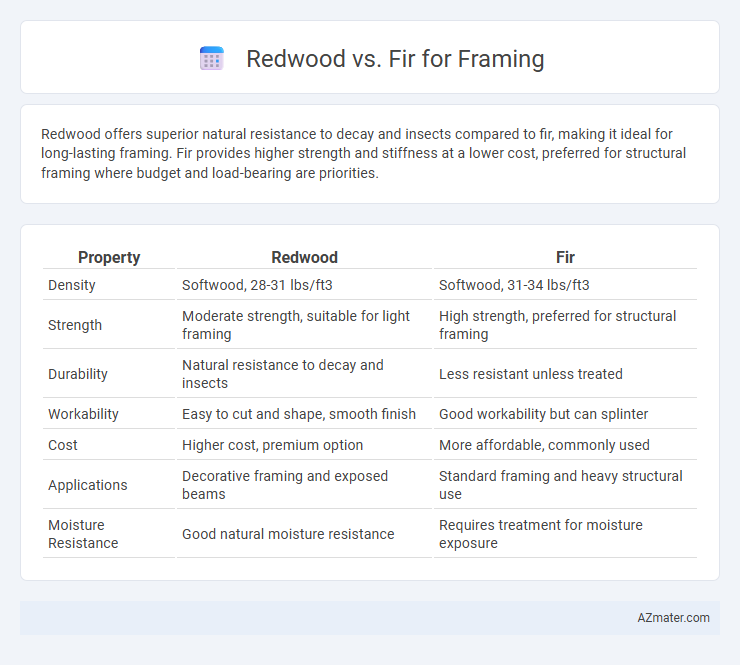Redwood offers superior natural resistance to decay and insects compared to fir, making it ideal for long-lasting framing. Fir provides higher strength and stiffness at a lower cost, preferred for structural framing where budget and load-bearing are priorities.
Table of Comparison
| Property | Redwood | Fir |
|---|---|---|
| Density | Softwood, 28-31 lbs/ft3 | Softwood, 31-34 lbs/ft3 |
| Strength | Moderate strength, suitable for light framing | High strength, preferred for structural framing |
| Durability | Natural resistance to decay and insects | Less resistant unless treated |
| Workability | Easy to cut and shape, smooth finish | Good workability but can splinter |
| Cost | Higher cost, premium option | More affordable, commonly used |
| Applications | Decorative framing and exposed beams | Standard framing and heavy structural use |
| Moisture Resistance | Good natural moisture resistance | Requires treatment for moisture exposure |
Introduction to Redwood and Fir for Framing
Redwood and Fir are popular choices for framing due to their strength, durability, and workability. Redwood offers natural resistance to decay and insects, making it ideal for outdoor or moisture-prone framing projects. Fir, particularly Douglas Fir, is favored for its high strength-to-weight ratio, uniform grain, and widespread availability, ensuring reliable structural support in residential and commercial construction.
Wood Species Overview: Redwood vs Fir
Redwood, known for its natural resistance to decay and insects, offers durability and a rich reddish hue ideal for framing exposed to moisture. Fir, especially Douglas Fir, features high strength-to-weight ratio and consistent grain, making it a preferred choice for structural framing due to superior load-bearing capacity. Both species provide excellent stability, but Redwood excels in outdoor applications, while Fir is favored for cost-effective, reliable indoor framing.
Strength and Structural Performance
Redwood offers excellent strength-to-weight ratio, making it a popular choice for framing where durability and resistance to warping are critical. Fir, particularly Douglas Fir, exhibits superior structural performance with higher stiffness and load-bearing capacity, often preferred in heavy construction for its reliability. Both woods provide solid framing options, but Fir generally outperforms Redwood in strength metrics crucial for long-span and heavy-load applications.
Durability and Resistance to Decay
Redwood offers superior durability and natural resistance to decay due to its high tannin content, making it an excellent choice for framing in environments prone to moisture and insect exposure. Fir, while strong and commonly used in construction, has less natural decay resistance and typically requires chemical treatment to enhance its longevity. Choosing redwood for framing ensures longer-lasting structural integrity with minimal maintenance under adverse conditions.
Workability and Ease of Construction
Redwood offers superior workability compared to fir due to its softer texture, which allows for easier cutting, nailing, and shaping during framing construction. Fir, while denser and stronger, can present more resistance to tools, leading to slightly longer construction times and increased effort. Both woods provide reliable framing support, but the ease of handling makes redwood a preferred choice for faster and more efficient framing projects.
Cost Comparison: Redwood vs Fir
Redwood framing typically costs more than fir due to its natural resistance to decay and insect damage, making it a premium choice for durability. Fir is generally more affordable and widely available, offering a cost-effective solution without compromising structural integrity in standard construction. The price difference can range from 20% to 40%, depending on regional availability and lumber grade.
Environmental Impact and Sustainability
Redwood framing offers superior sustainability due to its natural resistance to decay, reducing the need for chemical treatments and extending the lifespan of the structure. Fir, often sourced from faster-growing, sustainably managed plantations, provides a lower environmental impact through efficient carbon sequestration and reduced logging pressures. Choosing redwood minimizes environmental degradation in old-growth forests, while fir supports responsible forestry practices, making both viable options depending on specific sustainability priorities.
Availability and Sourcing
Redwood is less commonly used for framing due to its limited availability, primarily sourced from the West Coast of the United States, making it more expensive and harder to procure in large quantities. Fir, especially Douglas Fir, is widely available across North America and globally, making it a preferred choice for framing due to its consistent supply and easier sourcing from sustainable forests. The reliable availability of Fir reduces project delays and overall costs compared to the more niche sourcing requirements of Redwood.
Common Applications in Framing
Redwood and fir are widely used in framing due to their strength and availability, with fir being a popular choice for structural framing in residential and commercial buildings because of its straight grain and resistance to warping. Redwood is often preferred for decorative framing elements and outdoor structural components due to its natural resistance to decay and insects. Common applications of fir include wall studs, joists, and rafters, while redwood is favored for exposed framing and areas needing enhanced durability.
Final Recommendations: Choosing the Right Wood for Your Project
Redwood offers superior resistance to decay and insects, making it ideal for outdoor framing projects requiring durability and longevity. Fir provides excellent strength and stability at a lower cost, suited for interior framing where budget and structural integrity are priorities. Choose redwood for long-term exposure and aesthetic appeal, while fir is best for cost-effective, strong framing in controlled environments.

Infographic: Redwood vs Fir for Framing
 azmater.com
azmater.com